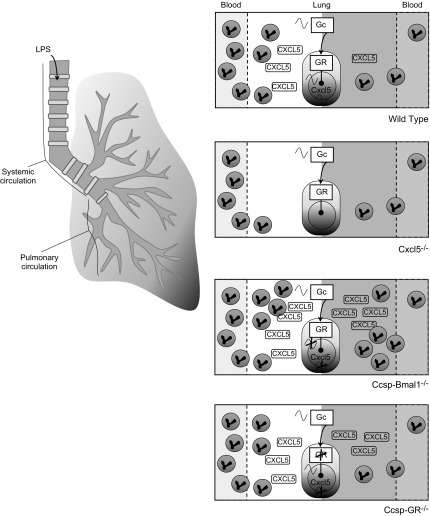Figure 8.
The gated LPS response. WT: Upon stimulation with LPS, inflammatory signaling pathways in the lung are engaged, resulting in production of proinflammatory chemokines and neutrophil influx through the pulmonary circulation (42, 43). In WT animals, the clock regulates access to modulatory regions of chromatin, including an enhancer region in the Cxcl5 sequence to which GR has been shown to bind with inhibitory effects upon transcription. At CT12, GR binding is permitted, and cell influx is suppressed relative to the challenge at CT0. A strong signal (CXCL5) combined with more neutrophils in the circulation during the day (34) leads to an oscillation in infiltrating cell count (3). Cxcl5−/−: CXCL5 predominates in driving neutrophil influx to the alveolar space in the nebulized LPS model (30). Mice can no longer produce Cxcl5 upon LPS stimulation, resulting in low numbers of invading neutrophils at both time points. Some cells are still found in lavage fluid, indicating successful migration without a CXCL5 signal (3). Ccsp-Bmal1−/−: Without Bmal1 in the bronchial epithelial cells, the inhibitory binding of GR no longer occurs at CT12 and gating of CXCL5 production is lost. Production of CXCL5 is enhanced and increased neutrophilia occurs at both time points without a day/night variation in infiltrating cell number (3). Ccsp-GR−/−: Without GR in the bronchial epithelial cells, the inhibitory binding of GR no longer occurs at CT12, and gating of CXCL5 production is lost despite the presence of an intact circadian clock. However, an intact oscillation in cell influx remains. A nonrhythmic signal (CXCL5), combined with oscillations in neutrophil count in the bloodstream (34), still results in an oscillation in infiltrating cell count.

